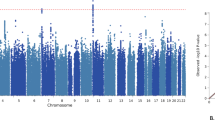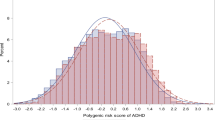Abstract
Attention-deficit hyperactivity disorder (ADHD) is a heritable disorder, prevalent from childhood through adulthood. Although the noradrenergic (NA) system is thought to mediate a portion of the pathophysiology of ADHD, genes in this pathway have not been investigated as frequently as those in the dopaminergic system. Previous association studies of one candidate gene in the NA system, ADRA2A, showed inconsistent results with regard to an MspI polymorphism. In the current study, two nearby single-nucleotide polymorphisms, which define HhaI and DraI restriction fragment length polymorphisms, were also genotyped and were in significant linkage disequilibrium with the MspI RFLP. Transmission disequilibrium tests (TDTs) in a sample of 177 nuclear families showed significant association and linkage of the DraI polymorphism with the ADHD combined subtype (P=0.03), and the quantitative TDT showed association of this polymorphism with the inattentive (P=0.003) and hyperactive-impulsive (P=0.015) symptom dimensions. The haplotype that contained the less common allele of the DraI polymorphism likewise showed a strong relationship with the inattentive (P=0.001) and hyperactive-impulsive (P=0.004) symptom dimensions. This study supports the hypothesis that an allele of the ADRA2A gene is associated and linked with the ADHD combined subtype and suggests that the DraI polymorphism of ADRA2A is linked to a causative polymorphism.
This is a preview of subscription content, access via your institution
Access options
Subscribe to this journal
Receive 12 print issues and online access
$259.00 per year
only $21.58 per issue
Buy this article
- Purchase on Springer Link
- Instant access to full article PDF
Prices may be subject to local taxes which are calculated during checkout

Similar content being viewed by others
References
American Psychiatric Association. Diagnostic and Statistical Manual of Mental Disorders, 4th edn.—Text revision. APA Press: Washington, DC, 2000.
Faraone SV, Doyle AE . The nature and heritability of attention-deficit/hyperactivity disorder. Child Adolesc Psychiatr Clin N Am 2001; 10: 299–316, viii–ix.
Spencer TJ, Biederman J, Wilens TE, Faraone SV . Overview and neurobiology of attention-deficit/hyperactivity disorder. J Clin Psychiatry 2002; 63 (Suppl 12): 3–9.
Willcutt EG, Pennington BF, DeFries JC . Etiology of inattention and hyperactivity/impulsivity in a community sample of twins with learning difficulties. J Abnorm Child Psychol 2000; 28: 149–159.
Smalley SL . Genetic influences in childhood-onset psychiatric disorders: autism and attention-deficit/hyperactivity disorder. Am J Hum Genet 1997; 60: 1276–1282.
Greenhill L . Clinical effects of stimulant medication in ADHD. In: Solanto MV, Arnsten AFT, Castellanos FX (eds). Stimulant Drugs and ADHD: Basic and Clinical Neuroscience. Oxford University Press: New York, 2001 pp 31–72.
Faraone SV, Doyle AE, Mick E, Biederman J . Meta-analysis of the association between the 7-repeat allele of the dopamine D(4) receptor gene and attention deficit hyperactivity disorder. Am J Psychiatry 2001; 158: 1052–1057.
Maher BS, Marazita ML, Ferrell RE, Vanyukov MM . Dopamine system genes and attention deficit hyperactivity disorder: a meta-analysis. Psychiatr Genet 2002; 12: 207–215.
Lowe N, Kirley A, Hawi Z, Sham P, Wickham H, Kratochvil CJ et al. Joint analysis of the DRD5 marker concludes association with attention-deficit/hyperactivity disorder confined to the predominantly inattentive and combined subtypes. Am J Hum Genet 2004; 74: 348–356.
Arnsten AF, Steere JC, Hunt RD . The contribution of alpha 2-noradrenergic mechanisms of prefrontal cortical cognitive function. Potential significance for attention-deficit hyperactivity disorder. Arch Gen Psychiatry 1996; 53: 448–455.
Arnsten AFT . Dopaminergic and noradrenergic influences on cognitive functions mediated by prefrontal cortex. In: Solanto MV, Arnsten AFT, Castellanos FX (eds). Stimulant Drugs and ADHD: Basic and Clinical Neuroscience. Oxford University Press: New York, 2001 pp 185–208.
Berridge CW . Arousal- and attention-related actions of the locus coeruleus-noradrenergic system: potential target in the therapeutic actions of amphetamine-like stimulants. In: Solanto MV, Arnsten AFT, Castellanos FX (eds). Stimulant Drugs and ADHD: Basic and Clinical Neuroscience. Oxford University Press: New York, 2001 pp 158–184.
Posner MPS . The attention system of the human brain. Annu Rev Neurosci 1990; 13: 25–42.
Berger A, Posner MI . Pathologies of brain attentional networks. Neurosci Biobehav Rev 2000; 24: 3–5.
Sergeant JA, Oosterlaan J, can der Meere J . Information processing and energetic factors in attention-deficit/hyperactivity disorder. In: Hogan HCQAE (ed). Handbook of Disruptive Behavior Disorders. Kluwer/Plenum: New York, 1999 pp 75–104.
van der Meere J, Stemerdink N . The development of state regulation in normal children: an indirect comparison with children with ADHD. Dev Neuropsychol 1999; 16: 213–225.
Barkley RA . Behavioral inhibition, sustained attention, and executive functions: constructing a unifying theory of ADHD. Psychol Bull 1997; 121: 65–94.
Shaffer D, Fisher P, Lucas C . NIMH Diagnostic Interview Schedule for Children—IV. Ruane Center for Early Diagnosis, Division of Child Psychiatry, Columbia University: New York, 1997.
Zentall SZT . Optimal stimulation: a model of disordered activity and performance in normal and deviant children. Psychol Bull 1983; 94: 446–471.
McCracken JT . A two-part model of stimulant action on attention-deficit hyperactivity disorder in children. J Neuropsychiatry Clin Neurosci 1991; 3: 201–209.
Malone MA, Kershner JR, Swanson JM . Hemispheric processing and methylphenidate effects in attention-deficit hyperactivity disorder. J Child Neurol 1994; 9: 181–189.
Barry RJ, Johnstone SJ, Clarke AR . A review of electrophysiology in attention-deficit/hyperactivity disorder: II. Event-related potentials. Clin Neurophysiol 2003; 114: 184–198.
Losier BJ, McGrath PJ, Klein RM . Error patterns on the continuous performance test in non-medicated and medicated samples of children with and without ADHD: a meta-analytic review. J Child Psychol Psychiatry 1996; 37: 971–987.
Huang-Pollock CL, Nigg JT . Searching for the attention deficit in attention deficit hyperactivity disorder: the case of visuospatial orienting. Clin Psychol Rev 2003; 23: 801–830.
Oosterlaan J, Logan GD, Sergeant JA . Response inhibition in AD/HD, CD, comorbid AD/HD+CD, anxious, and control children: a meta-analysis of studies with the stop task. J Child Psychol Psychiatry 1998; 39: 411–425.
Jakala P, Riekkinen M, Sirvio J, Koivisto E, Kejonen K, Vanhanen M et al. Guanfacine, but not clonidine, improves planning and working memory performance in humans. Neuropsychopharmacology 1999; 20: 460–470.
Biederman J, Spencer T . Attention-deficit/hyperactivity disorder (ADHD) as a noradrenergic disorder. Biol Psychiatry 1999; 46: 1234–1242.
Franowicz JS, Arnsten AF . The alpha-2a noradrenergic agonist, guanfacine, improves delayed response performance in young adult rhesus monkeys. Psychopharmacology (Berl) 1998; 136: 8–14.
Comings DE, Gade-Andavolu R, Gonzalez N, Blake H, Wu S, MacMurray JP . Additive effect of three noradrenergic genes (ADRA2a, ADRA2C, DBH) on attention-deficit hyperactivity disorder and learning disabilities in Tourette syndrome subjects. Clin Genet 1999; 55: 160–172.
Comings DE, Gonzalez NS, Cheng Li SC, MacMurray J . A ‘line item’ approach to the identification of genes involved in polygenic behavioral disorders: the adrenergic alpha2A (ADRA2A) gene. Am J Med Genet 2003; 118B: 110–114.
Xu C, Schachar R, Tannock R, Roberts W, Malone M, Kennedy JL et al. Linkage study of the alpha2A adrenergic receptor in attention-deficit hyperactivity disorder families. Am J Med Genet 2001; 105: 159–162.
Roman T, Schmitz M, Polanczyk GV, Eizirik M, Rohde LA, Hutz MH . Is the alpha-2A adrenergic receptor gene (ADRA2A) associated with attention-deficit/hyperactivity disorder? Am J Med Genet 2003; 120B: 116–120.
Wechsler D . Wechsler Intelligence Scale for Children, 3rd edn. Psychological Corporation: San Antonio, TX, 1991.
Reynolds CKR . Behavior Assessment System for Children: Manual. American Guidance Service, Inc.: Circle Pines: Minnesota, 1992.
Conners K . Conners’ Rating Scales—Revised Technical Manual. Multi Health Systems: New York, NY, 1997.
Lahey BB, Applegate B, McBurnett K, Biederman J, Greenhill L, Hynd GW et al. DSM-IV field trials for attention deficit hyperactivity disorder in children and adolescents. Am J Psychiatry 1994; 151: 1673–1685.
Robins LN, Cottler LB, Bucholz KK, Compton WM, North CS, Rourke KM . Diagnostic Interview Schedule for DSM-IV (DIS-IV). Washington University: St. Louis, MO, 1995.
Swanson JM, Lerner MA, March J, Gresham FM . Assessment and intervention for attention—deficit/hyperactivity disorder in schools: lessons from the MTA study. Ped Clin N Amer 1998; 46: 993–1009.
Meulenbelt I, Droog S, Trommelen GJ, Boomsma DI, Slagboom PE . High-yield noninvasive human genomic DNA isolation method for genetic studies in geographically dispersed families and populations. Am J Hum Genet 1995; 57: 1252–1254.
Ewens WJ, Spielman RS . The transmission/disequilibrium test: history, subdivision, and admixture. Am J Hum Genet 1995; 57: 455–464.
Abecasis GR, Cardon LR, Cookson WO . A general test of association for quantitative traits in nuclear families. Am J Hum Genet 2000; 66: 279–292.
Abecasis GR, Cookson WO, Cardon LR . Pedigree tests of transmission disequilibrium. Eur J Hum Genet 2000; 8: 545–551.
Abecasis GR, Cookson WO . GOLD—graphical overview of linkage disequilibrium. Bioinformatics 2000; 16: 182–183.
Milich R, Balentine AC, Lynam DR . ADHD combined type and ADHD predominantly inattentive type are distinct and unrelated disorders. Clin Psychol Sci Practice 2001; 8: 463–488.
Pritchard JK, Przeworski M . Linkage disequilibrium in humans: models and data. Am J Hum Genet 2001; 69: 1–14.
Comings DE . Clinical and molecular genetics of ADHD and Tourette syndrome. Two related polygenic disorders. Ann NY Acad Sci 2001; 931: 50–83.
Lario S, Calls J, Cases A, Oriola J, Torras A, Rivera F . MspI identifies a biallelic polymorphism in the promoter region of the alpha 2A-adrenergic receptor gene. Clin Genet 1997; 51: 129–130.
Feng J, Sobell JL, Heston LL, Goldman D, Cook Jr E, Kranzler HR et al. Variants in the alpha2A AR adrenergic receptor gene in psychiatric patients. Am J Med Genet 1998; 81: 405–410.
Hoehe MR, Berrettini WH, Lentes KU . Dra I identifies a two allele DNA polymorphism in the human alpha 2-adrenergic receptor gene (ADRAR), using a 5.5 kb probe (p ADRAR). Nucleic Acids Res 1988; 16: 9070.
Wolfarth B, Rivera MA, Oppert JM, Boulay MR, Dionne FT, Chagnon M et al. A polymorphism in the alpha2a-adrenoceptor gene and endurance athlete status. Med Sci Sports Exerc 2000; 32: 1709–1712.
Acknowledgements
This work was supported by the MSU Foundation (KF, JN) and NIMH grants MH59105 (JN) and MH-01818 (IDW).
Author information
Authors and Affiliations
Corresponding author
Rights and permissions
About this article
Cite this article
Park, L., Nigg, J., Waldman, I. et al. Association and linkage of α-2A adrenergic receptor gene polymorphisms with childhood ADHD. Mol Psychiatry 10, 572–580 (2005). https://doi.org/10.1038/sj.mp.4001605
Received:
Revised:
Accepted:
Published:
Issue Date:
DOI: https://doi.org/10.1038/sj.mp.4001605
Keywords
This article is cited by
-
Adrenergic neurotransmitter system transporter and receptor genes associated with atomoxetine response in attention-deficit hyperactivity disorder children
Journal of Neural Transmission (2013)
-
Sequence analysis of the ADRA2A coding region in children affected by attention deficit hyperactivity disorder
Neurological Sciences (2013)
-
A Family Based Association Study of DRD4, DAT1, and 5HTT and Continuous Traits of Attention-Deficit Hyperactivity Disorder
Behavior Genetics (2011)
-
The role of the ADRA2A C1291G genetic polymorphism in response to dexmedetomidine on patients undergoing coronary artery surgery
Molecular Biology Reports (2011)
-
Adrenergic α2A receptor gene is not associated with methylphenidate response in adults with ADHD
European Archives of Psychiatry and Clinical Neuroscience (2011)



